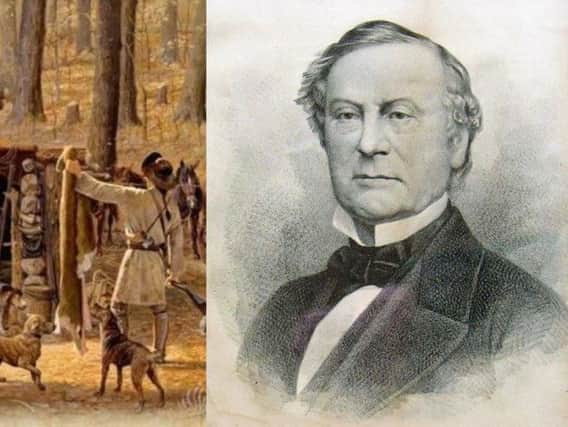Yank named Miranda who became a British barnet


He was so-called because his father thought that while bestowing him a girl’s name would doubtless bring much derision and ridicule it would ensure he’d have to learn how to fight to earn respect.I’m not sure if Curtis Lampson’s father had the same aim in mind when he gave his son the middle name of Miranda. If so it certainly did the lad no harm. Indeed he seemed to revel in the monicker and later in life, when he was a successful millionaire, he even called his yacht “Miranda”.Curtis Miranda Lampson was born in Vermont, USA, in 1806. His grandfather had fought against the British in the American War of Independence. Curtis had a basic education and at the age of 17 left home to go join his older brother William in Canada as a fur trader supplying the Hudson Bay Company. Curtis spent time with fur trappers and various Indian tribes and acquired much knowledge and experience of how the fur business worked.By all accounts Curtis cut a striking figure, being handsome and possessed of a gravitas beyond his age. Within a few years he quit the backwoods and moved to New York where he secured a position with fur trader and all-round entrepreneur John Jacob Astor. The latter would go on to become the richest man in America and Curtis would have learned much from the mogul’s modus operandi.Aged 21, Curtis married Jane Sibley in New York. He became a frequent trans-Atlantic traveller accompanying lucrative cargoes of furs that were much sought-after in Europe. With an obvious eye for an opportunity, Curtis set up his own fur merchants in London in 1830. He evidently very much liked England for he stayed here for the rest of his life, eventually setting up home in a beautiful Elizabethan house in the Sussex hamlet of Rowfant, near Crawley Down. His four children were born there and in 1849 he was granted British citizenship.Lampson’s fur business flourished and Curtis acquired further properties in the Scottish Highlands and on the Isle of Wight where he was neighbour to Alfred Lord Tennyson. The poet had his own West Sussex home at Blackdown and the two became close friends. In 1856 Curtis was elected to the Board of the Atlantic Telegraph Company. Early efforts to lay a cable on the seafloor between Ireland and America had failed but in 1866 Brunel’s ship, “The Great Eastern”, succeeded. Curtis profited from shrewd investments in the cable company and also the vessel. Another investor in both was the distinguished civil engineer Thomas Brassey of St. Leonards-on-Sea, East Sussex, a gentleman whose life story featured in this column last year.Lampson’s contribution as vice-chairman of the cable enterprise was recognized in November 1866 when he was created a baronet (hereditary knight). He was the first former US citizen to be so honoured.Curtis Lampson also became a Trustee of the Peabody Estates that provided housing for poor working men and their families in London. Founder of the charity was philanthropist George Peabody, another anglophile American who was good friends with Curtis. Indeed, Peabody died in 1869 while a guest in a house Lampson owned in London.Curtis spent plenty of time in and around his 300-acre Rowfant estate. His daughter Jane kept a diary and in one entry wrote of how her father complained that the vicar spoke too quickly in church and “gobbled” his prayers. Now it so happens that Lampson’s birthplace in Vermont was home to millions of turkeys. Coincidence or maybe an unconscious hark back to his youth?Sir Curtis Lampson died at Rowfant in 1885 and was buried in Worth churchyard. His son-in-law’s memoirs contained this eulogy: “I am told that as a youth he was wise and intelligent beyond his years. He had foresight, judgment, a clear apprehension of men and affairs and a strong will. His success in life may be attributed to his own sole exertions.”Grandson Godfrey Locker-Lampson wrote: “He was tall and broad-shouldered and had a great dignity about him and yet a gentleness that won you over. A grave, somewhat stern expression could be lit up by a smile that was irresistible.”Sir Curtis Lampson’s descendents are worthy of column inches in their own right so I will continue the family story next week. Meanwhile let me relate to you an avian curiosity concerning the village of Rowfant. The following tale is recorded in the Natural History Museum: “In 1888, a pair of Great Titmouse (Parus Major) began to build their nest in the postbox which stood in the road at Rowfant, and into which letters etc were posted and collected daily. One of the birds was killed by a boy and the nest was not finished. “In 1889, a pair completed the nest, laid seven eggs, and began to sit. “One day, an unusually large number of postcards were dropped into, and nearly filled, the box, causing the birds to desert the nest, which was afterwards removed with the eggs. “In 1890, a pair built a new nest and laid seven eggs, and successfully reared a brood of five young. “Letters posted were often found lying on the back of the sitting bird, which never left the nest even when the door of the box was opened to take out the letters. “The birds went in and out by the postbox slit.”